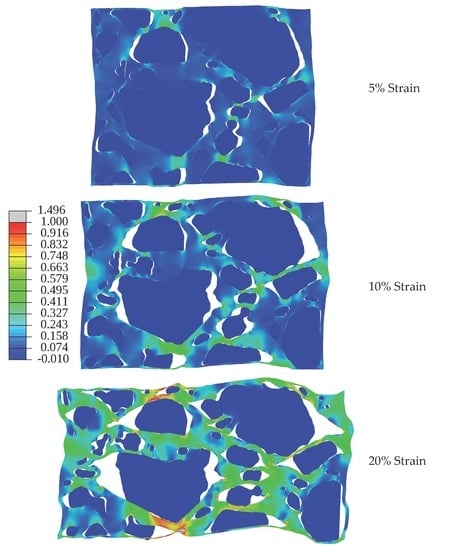In Situ Imaging during Compression of Plastic Bonded Explosives for Damage Modeling
Abstract
:1. Introduction
2. Materials and Methods
3. Results and Discussion
3.1. Mechanical Testing of HMX Formulations
3.2. In-Situ Tomography during Compression
3.3 Automated Microstructural Description from the CT Data
3.4. Application to Mesoscale Modeling
4. Conclusions
Acknowledgments
Author Contributions
Conflicts of Interest
References
- Palmer, S.J.P.; Field, J.E.; Huntley, J.M. Deformation, strengths and strains to failure of polymer bonded explosives. Proc. R. Soc. Lond. Ser. A 1993, 440, 399–419. [Google Scholar] [CrossRef]
- Yeager, J.D.; Ramos, K.J.; Singh, S.; Rutherford, M.E.; Majewski, J.; Hooks, D.E. Nanoindentation of explosive polymer composites to simulate deformation and failure. Mater. Sci. Technol. 2012, 28, 1147–1155. [Google Scholar] [CrossRef]
- Rae, P.J.; Goldrein, H.T.; Palmer, S.J.P.; Field, J.E.; Lewis, A.L. Quasi-static studies of the deformation and failure of β-HMX based polymer bonded explosives. Proc. R. Soc. A Mathemat. Phys. Eng. Sci. 2002, 458, 743–762. [Google Scholar] [CrossRef]
- Skidmore, C.B.; Phillips, D.S.; Howe, P.M.; Mang, J.T.; Romero, J.A. The evolution of microstructural changes in pressed HMX explosives. In Proceedings of the 11th International Detonation Symposium, Snowmass Village, CO, USA, 30 August–4 September 1998. [Google Scholar]
- Barua, A.; Zhou, M. Computational analysis of temperature rises in microstructures of HMX-Estane PBXs. Comput. Mech. 2013, 52, 151–159. [Google Scholar] [CrossRef]
- Willey, T.M.; Lauderbach, L.; Gagliardi, F.; van Buuren, T.; Glascoe, E.A.; Tringe, J.W.; Lee, J.R.I.; Springer, K.H.; Ilavsky, J. Mesoscale evolution of voids and microstructural changes in HMX-based explosives during heating through the β-δ phase transition. J. Appl. Phys. 2015, 118. [Google Scholar] [CrossRef]
- Parker, G.R.; Peterson, P.D.; Asay, B.W.; Dickson, P.M.; Perry, W.L.; Henson, B.F.; Smilowitz, L.; Oldenborg, M.R. Examination of morphological changes that affect gas permeation through thermally damaged explosives. Propellants Explos. Pyrotech. 2004, 29, 274–281. [Google Scholar] [CrossRef]
- Howe, P.M. Solid Propellant Chemistry, Combustion, and Motor Interior Ballistics(A 00-36332 09-28); American Institute of Aeronautics and Astronautics, Inc.: Reston, VA, USA, 2000; Volume 185, pp. 141–183. [Google Scholar]
- Hobbs, M.L.; Kaneshige, M.J.; Erikson, W.W. Modeling the measured effect of a nitroplasticizer (BDNPA/F) on cookoff of a plastic bonded explosive (PBX 9501). Combust. Flame 2016, 173, 132–150. [Google Scholar] [CrossRef]
- Berghout, H.L.; Son, S.F.; Skidmore, C.B.; Idar, D.J.; Asay, B.W. Combustion of damaged PBX 9501 explosive. Thermochim. Acta 2002, 384, 261–277. [Google Scholar] [CrossRef]
- Mang, J.T.; Hjelm, R.P. Small-angle neutron scattering and contrast variation measurement of the interfacial surface area in PBX 9501 as a function of pressing intensity. Propellants Explos. Pyrotech. 2011, 36, 439–445. [Google Scholar] [CrossRef]
- Salazar, M.R.; Kress, J.D.; Lightfoot, J.M.; Russel, B.G.; Rodin, W.A.; Woods, L. Experimental study of the oxidative degradation of PBX 9501 and its components. Propellants Explos. Pyrotech. 2008, 33, 182–202. [Google Scholar] [CrossRef]
- Thompson, D.G.; Deluca, R.; Brown, G.W. Time-temperature analysis, tension and compression in PBXs. J. Energ. Mater. 2012, 30, 299–323. [Google Scholar] [CrossRef]
- Tan, H.; Liu, C.; Huang, Y.; Geubelle, P.H. The Cohesive law for the particle/matrix interfaces in high explosives. J. Mech. Phys. Solids 2005, 53, 1892–1917. [Google Scholar] [CrossRef]
- Liu, C.; Thompson, D.G. Macroscopic Crack Formation and Extension in Pristine and Artificially Aged PBX 9501. In Proceedings of the 14th International Detonation Symposium, Coeur d'Alene, ID, USA, 11−16 April 2010. [Google Scholar]
- Hsu, P.C.; de Haven, M.; McClelland, M.; Tarver, C.; Chidester, S.; Maienschein, J. Characterization of Damaged Materials. In Proceedings of the 13th International Detonation Symposium, Norfolk, VA, USA, 23−28 July 2006. [Google Scholar]
- Blumenthal, W.; Thompson, D.; Cady, C.; Gray III, G.T.; Idar, D. Compressive properties of PBXN-110 and its HTPB-based binder as a function of temperature and strain rate. Proceedings the of 12th International Detonation Symposium, San Diego, CA, USA, 11–16 August 2002. [Google Scholar]
- Skidmore, C.B.; Phillips, D.S.; Son, S.F.; Asay, B.W. Characterization of HMX Particles in PBX 9501. AIP Conf. Proc. 1998, 429, 579–582. [Google Scholar]
- Siviour, C.R.; Laity, P.R.; Proud, W.G.; Field, J.E.; Porter, D.; Church, P.D.; Gould, P.; Huntingdon-Thresher, W. High strain rate properties of a polymer-bonded sugar: Their dependence on applied and internal constraints. Proc. R. Soc. Lond. Ser. A 2008, 464, 1229–1255. [Google Scholar] [CrossRef]
- Hu, Z.; Luo, H.; Bardenhagen, S.; Siviour, C.; Armstrong, R.; Lu, H. Internal deformation measurement of polymer bonded sugar in compression by digital volume correlation of in- situ tomography. Exp. Mech. 2015, 55, 289–300. [Google Scholar] [CrossRef]
- Patterson, B.M.; Henderson, K.; Smith, Z. Measure of Morphological and performance properties in polymeric silicone foams by X-Ray tomography. J. Mater. Sci. 2013, 48, 1986–1996. [Google Scholar] [CrossRef]
- Patterson, B.M.; Henderson, K.; Gilbertson, R.D.; Tornga, S.; Cordes, N.L.; Chavez, M.E.; Smith, Z. Morphological and performance measures of polyurethane foams using X-ray CT and mechanical testing. Microsc. Microanal. 2014, 20, 1284–1293. [Google Scholar] [CrossRef] [PubMed]
- Yeager, J.D.; Watkins, E.B.L.; Duque, A.H.; Majewski, J. The Thermal and microstructural effect of plasticizing HMX-nitrocellulose composites. J. Energ. Mater. 2017, 1–16. [Google Scholar] [CrossRef]
- Cordes, N.L.; Patterson, B.M.; Henderson, K.; Williams, J.J.; Stannard, T.; Singh, S.S.; Ovejero, A.R.; Xiao, X.H.; Robinson, M.; Chawla, N. In Situ X-Ray Synchrotron tomographic imaging during the compression of hyper-elastic polymeric materials. J. Mater. Sci. 2016, 51, 171–187. [Google Scholar]
- Croom, B.P.; Xu, P.; Lahoda, E.J.; Deck, C.P.; Li, X.D. Quantifying the three-dimensional damage and stress redistribution mechanisms of braided SiC/SiC composites by in situ volumetric digital image correlation. Scripta Mater. 2017, 130, 238–241. [Google Scholar] [CrossRef]
- Croom, B.; Wang, W.-M.; Li, J.; Li, X. Unveiling 3D deformations in polymer composites by coupled micro x-ray computed tomography and volumetric digital image correlation. Exp. Mech. 2016, 56, 999–1016. [Google Scholar] [CrossRef]
- Yang, W.; Liu, Q.; Yue, Z.; Li, X.; Xu, B. Rotation of hard particles in a soft matrix. J. Mech. Phys. Solids 2017, 101, 285–310. [Google Scholar] [CrossRef]
- Arora, H.; Charalambides, M.N.; Tarleton, E.; Williamson, D.M.; Leppared, C.L. An image based approach to modelling plastic bonded explosives (PBX) on the micro scale. In Proceedings of the 19th International Conference on Composite Materials, Montreal, Canada, July 28 – August 2, 2013. [Google Scholar]
- Arora, H.; Tarleton, E.; Li-Mayer, J.; Charalambides, M.; Lewis, D. Modelling the damage and deformation process in a plastic bonded explosive microstructure under tension using the finite element method. Comput. Mater. Sci. 2015, 110, 91–101. [Google Scholar]
- Barua, A.; Horie, Y.; Zhou, M. Energy localization in HMX-Estane polymer-bonded explosives during impact loading. J. Appl. Phys. 2012, 111. [Google Scholar] [CrossRef]
- Barua, A.; Kim, S.; Horie, Y.; Zhou, M. Ignition criterion for heterogeneous energetic materials based on hotspot size-temperature threshold. J. Appl. Phys. 2013, 113, 064906–064922. [Google Scholar] [CrossRef]
- Barua, A.; Zhou, M. A Lagrangian Framework for Analyzing microstructural level response of polymer-bonded explosives. Modell. Simul. Mater. Sci. Eng. 2011, 19. [Google Scholar] [CrossRef]
- Hu, R.; Prakash, C.; Tomar, V.; Harr, M.; Gunduz, I.E.; Oskay, C. Experimentally-validated mesoscale modeling of the coupled mechanical–thermal response of AP–HTPB energetic material under dynamic loading. Int. J. Fract. 2016, 203, 1–22. [Google Scholar] [CrossRef]
- Gilbert, J.; Chakravarthy, S.; Gonthier, K.A. Computational analysis of hot-spot formation by quasi-steady deformation waves in porous explosive. J. Appl. Phys. 2013, 113. [Google Scholar] [CrossRef]
- Chakravarthy, S.; Gonthier, K.A. Analysis of Microstructure-dependent shock dissipation and hot-spot formation in granular metalized explosive. J. Appl. Phys. 2016, 120. [Google Scholar] [CrossRef]
- Rao, P.T.; Gonthier, K.A.; Chakravarthy, S. Compaction shock dissipation in low density granular explosive. J. Appl. Phys. 2016, 119, 224904. [Google Scholar] [CrossRef]
- Bradski, G.; Kaehler, A. Dr. Dobb’s Journal of Software Tools 2000. Available online: http://mirror.sysu.edu.cn/wiki.ros.org/attachments/Events(2f)ICRA2010Tutorial/ICRA_2010_OpenCV_Tutorial.pdf (accessed on 13 November 2016).
- Blacker, T.D.; Bohnhoff, W.J.; Edwards, T.L. CUBIT Mesh Generation Environment; Sandia National Labs: Albuquerque, NM USA, 1994. [Google Scholar]
- Niu, R.M.; Zhou, Q.C.; Chen, X.; Ju, Y.T.; Wei, Z.; Zheng, J. Experimental and numerical analysis of mode II fracture between propellant and insulation. Int. J. Adhes. Adhes. 2014, 52, 1–10. [Google Scholar] [CrossRef]
- Prakash, C.; Verma, D.; Exner, M.; Gunduz, E.; Tomar, V. Strain rate dependent failure of interfaces examined via nanoimpact experiments. Chall. Mech. Time Depend. Mater. 2017, 2, 93–102. [Google Scholar]
- Hooks, D.E.; Ramos, K.J.; Bolme, C.A.; Cawkwell, M.J. Elasticity of crystalline molecular explosives. Propellants Ex. Pyrotech. 2015, 40, 333–350. [Google Scholar] [CrossRef]
- Van der Sluis, O.; Schreurs, P.J.G.; Brekelmans, W.A.M.; Meijer, H.E.H. Overall behaviour of heterogeneous elastoviscoplastic materials: effect of microstructural modelling. Mech. Mater. 2000, 32, 449–462. [Google Scholar] [CrossRef]
- Luscher, D.; McDowell, D.; Bronkhorst, C. Essential features of fine scale boundary conditions for second gradient multiscale homogenization of statistical volume elements. Int. J. Multiscale Comput. Eng. 2012, 10, 461–486. [Google Scholar] [CrossRef]
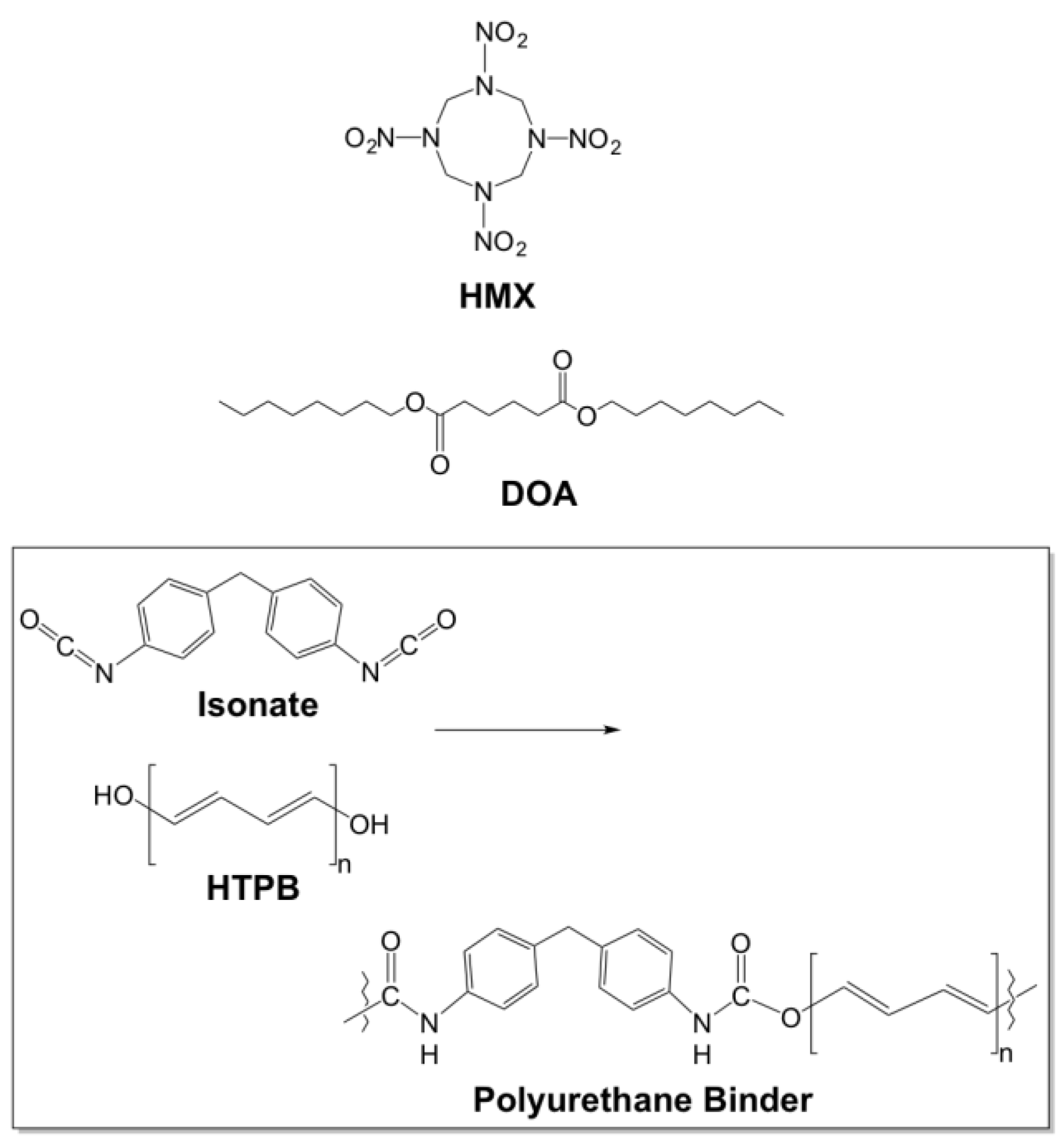
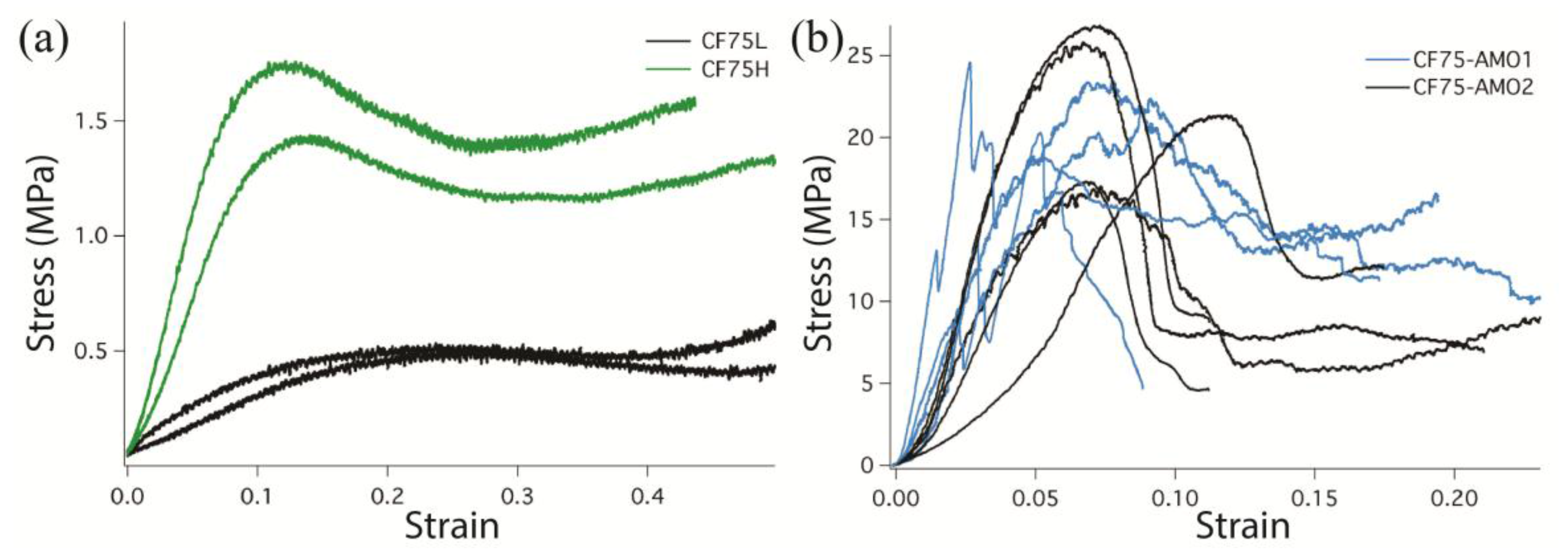
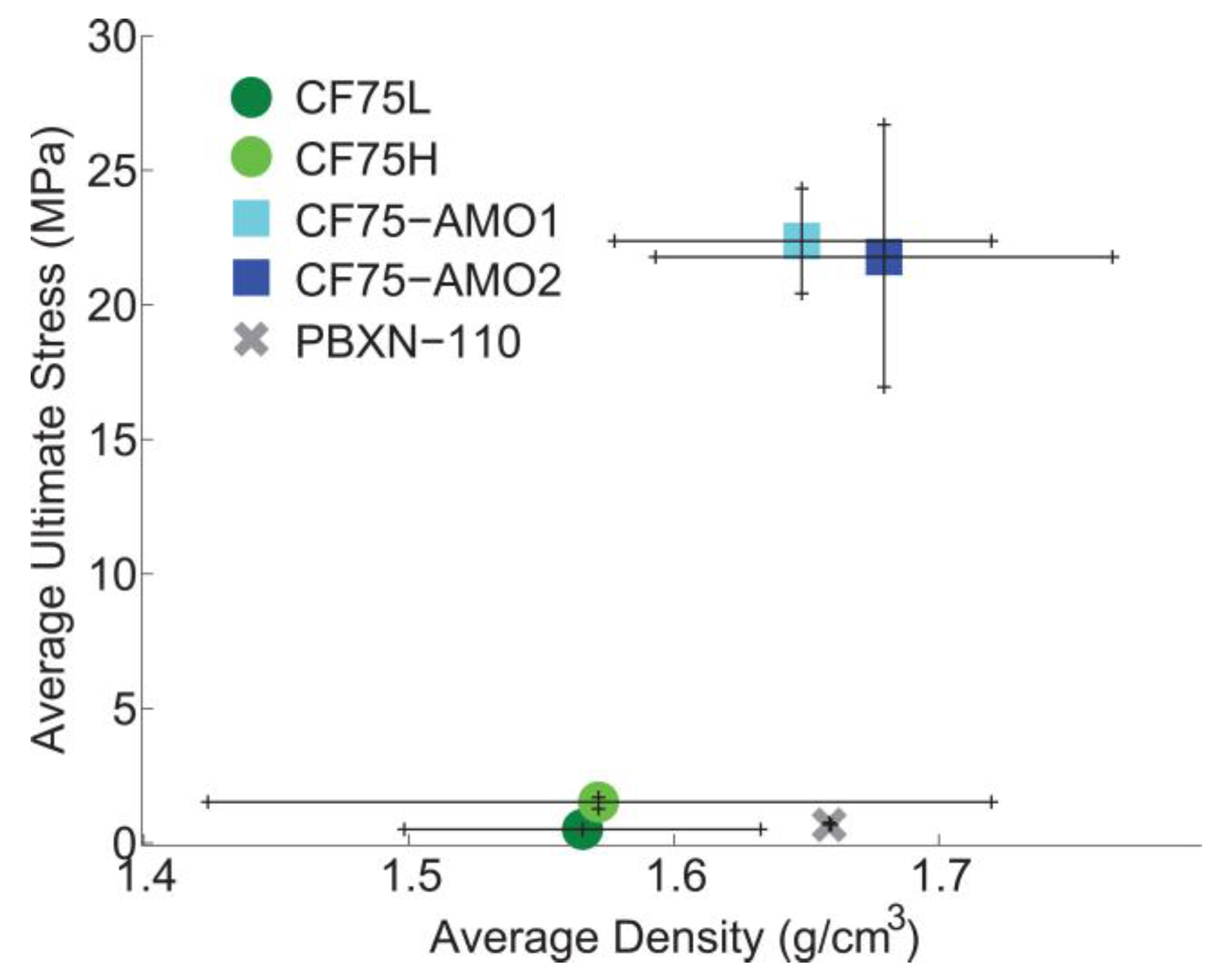
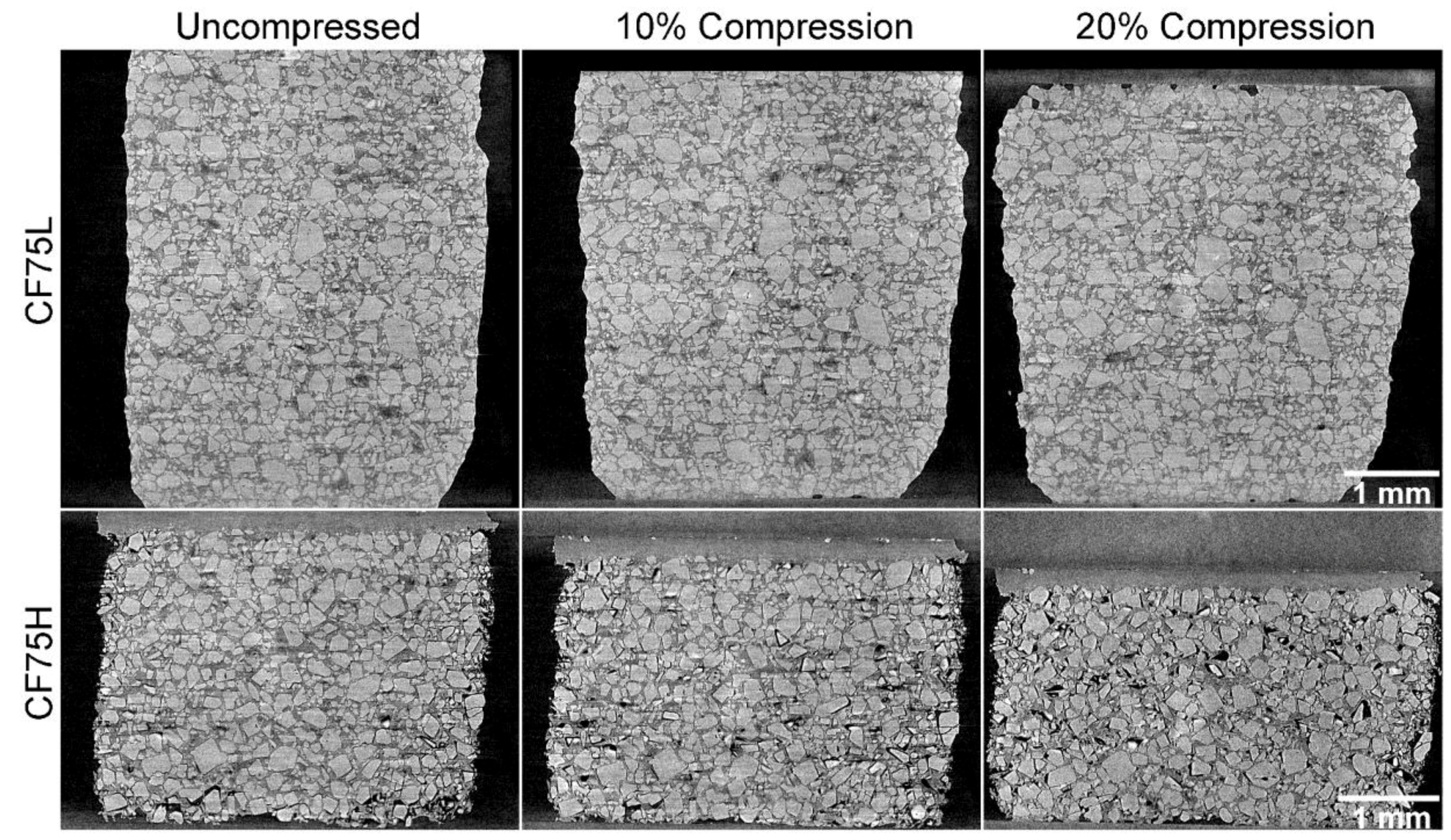
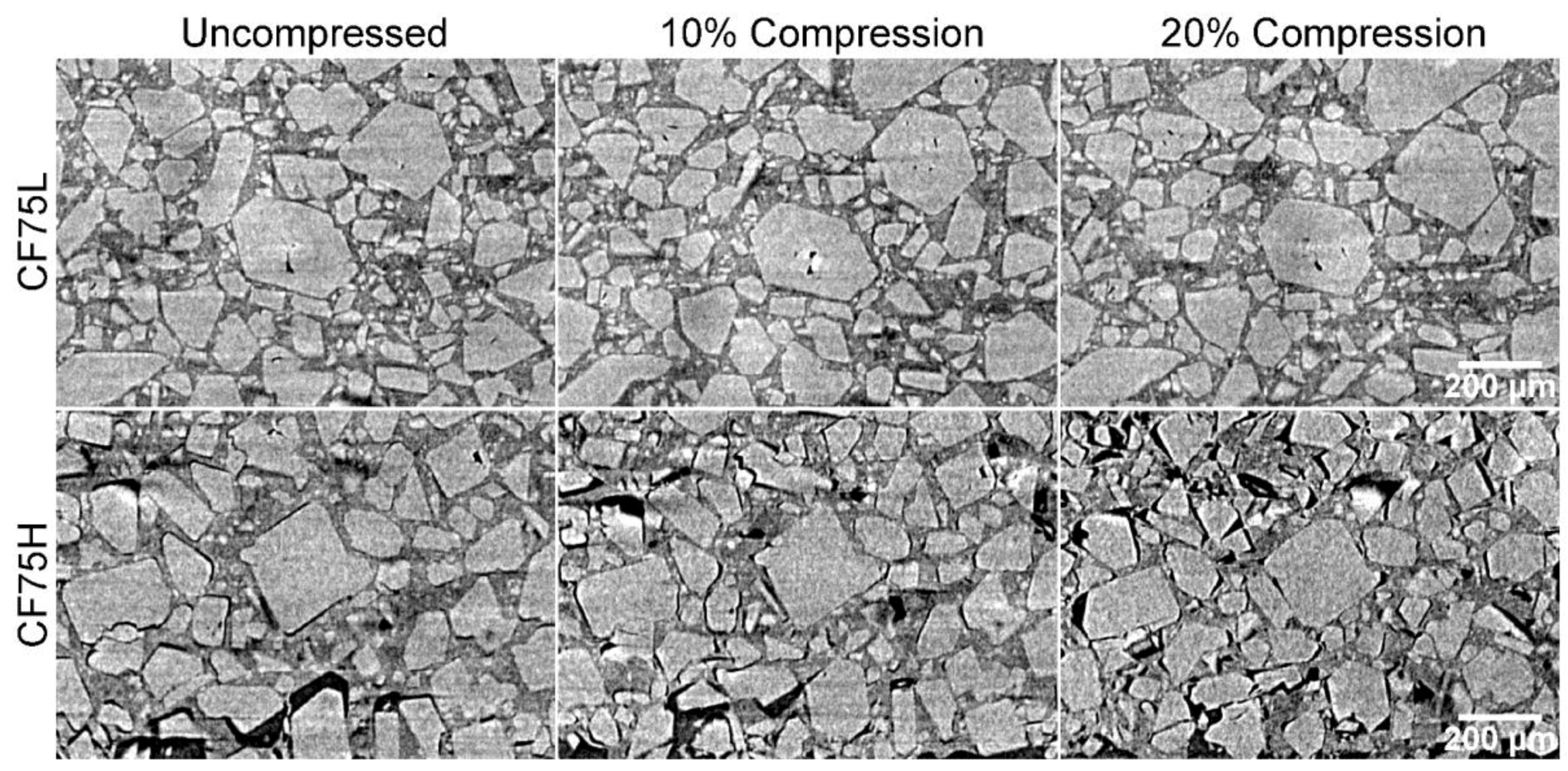
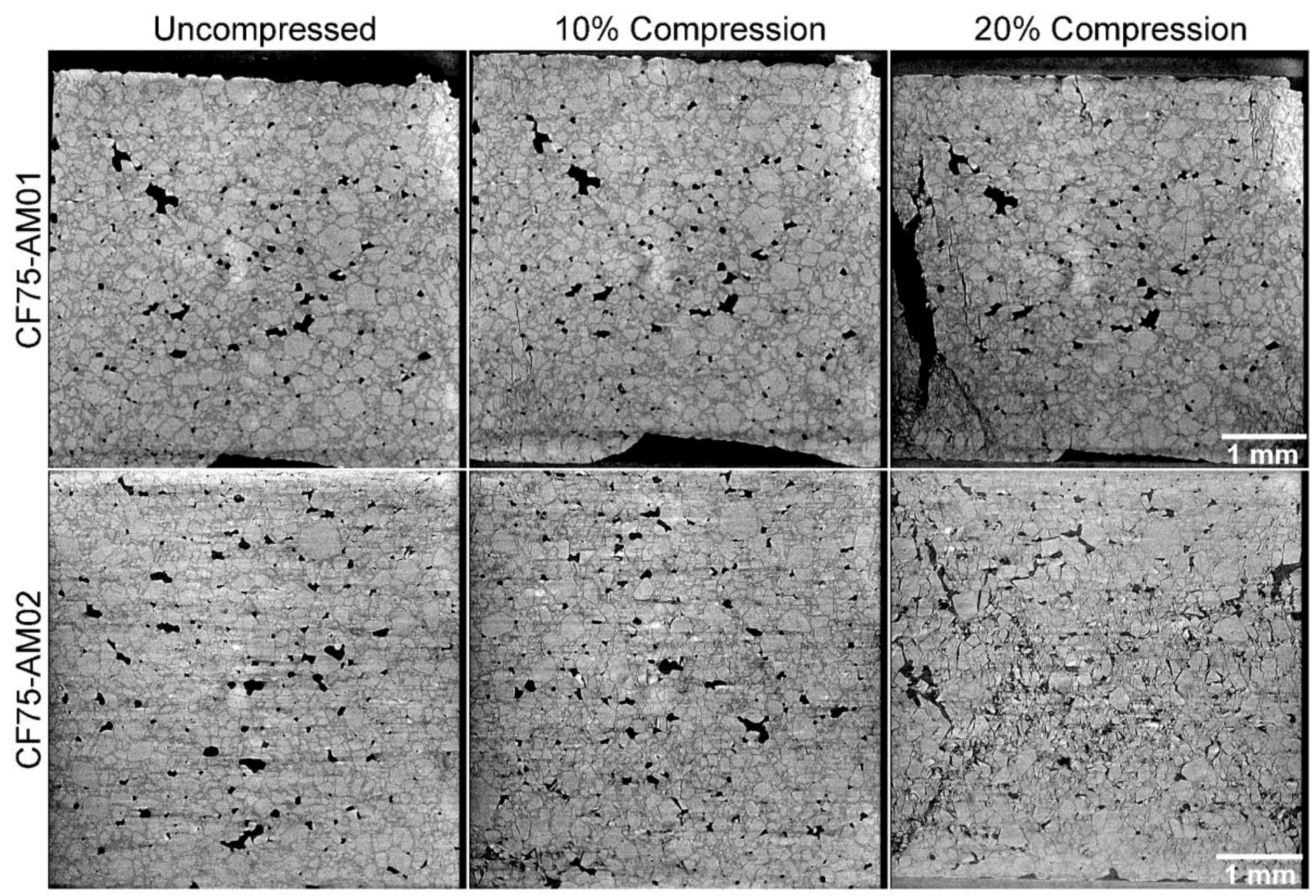
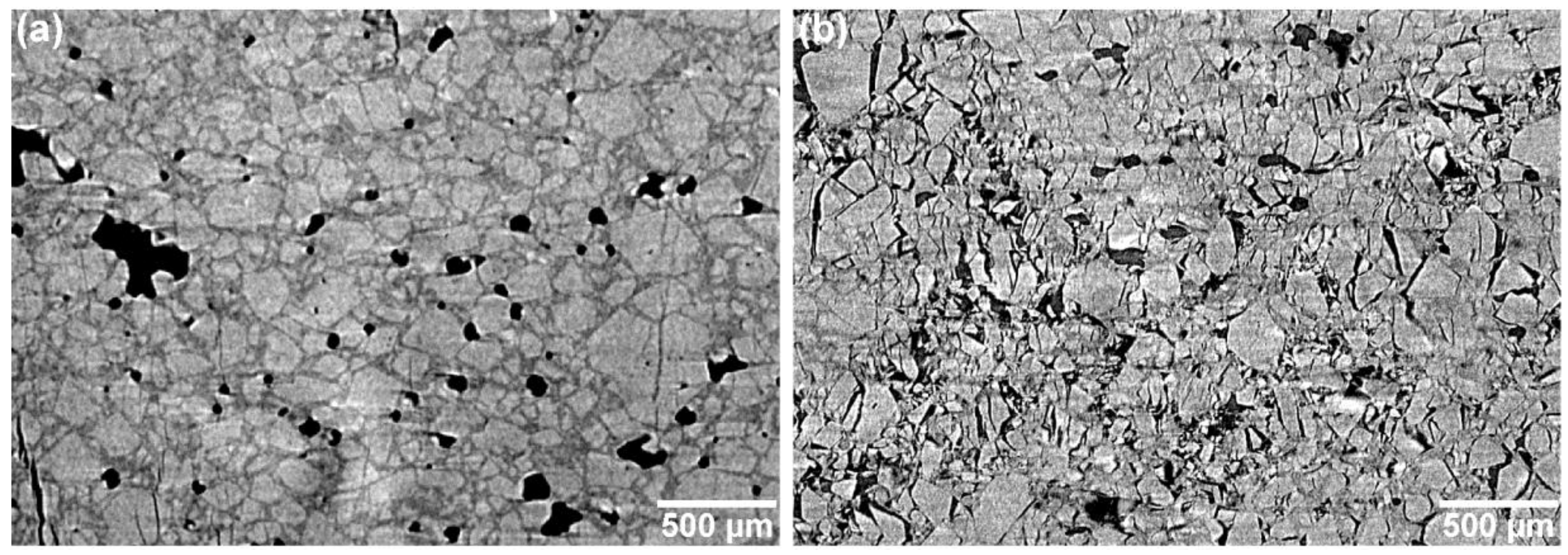
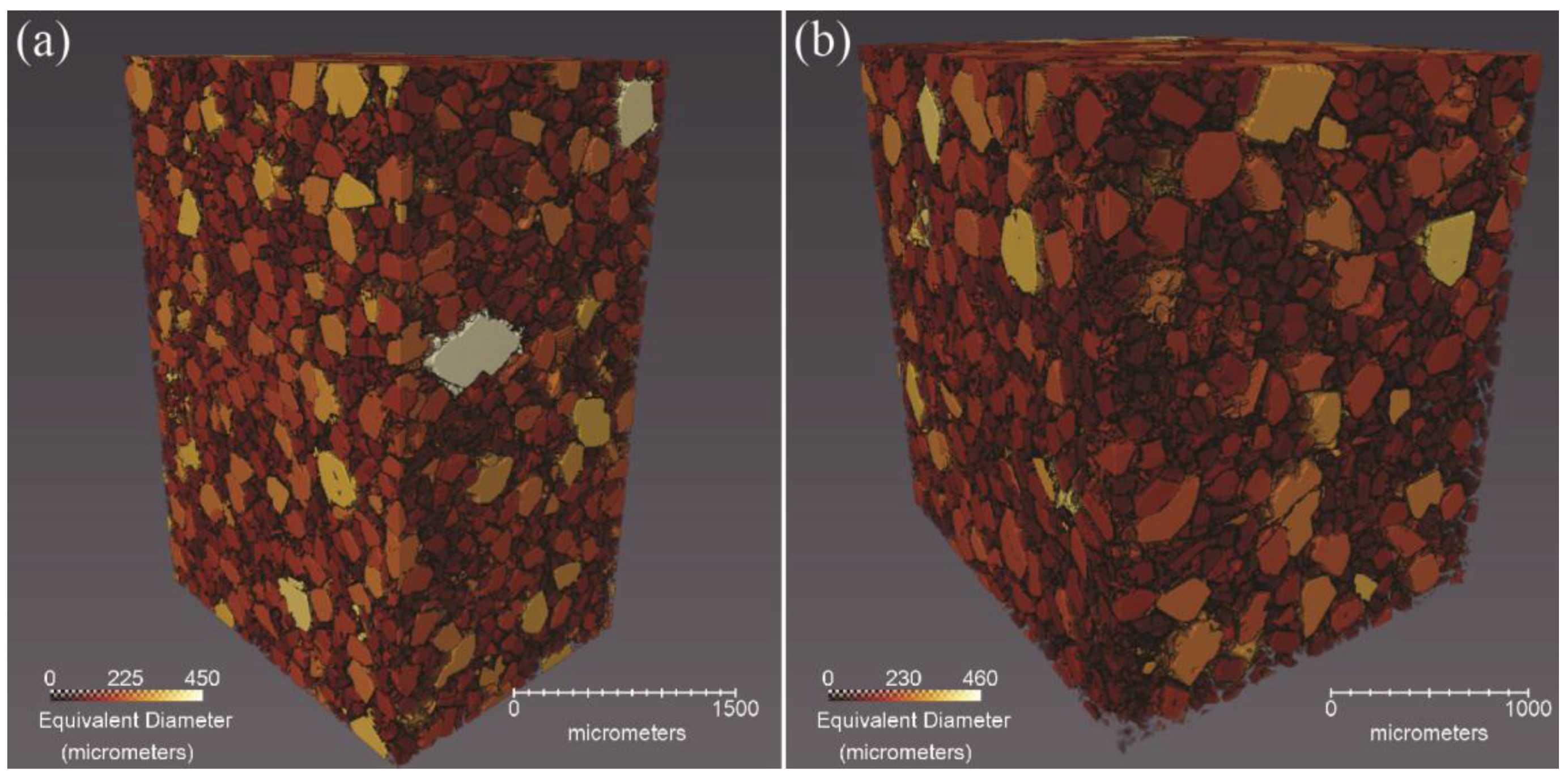
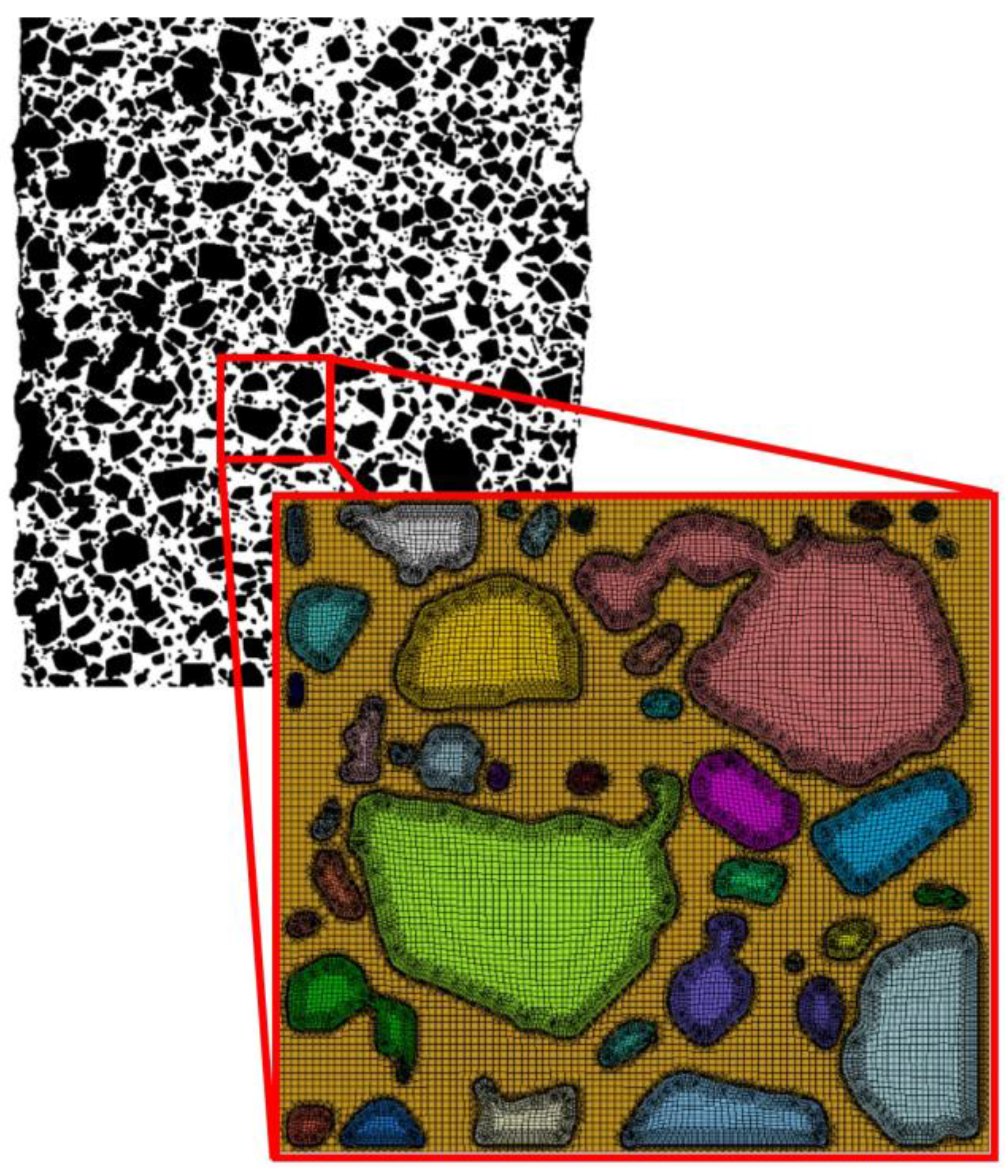
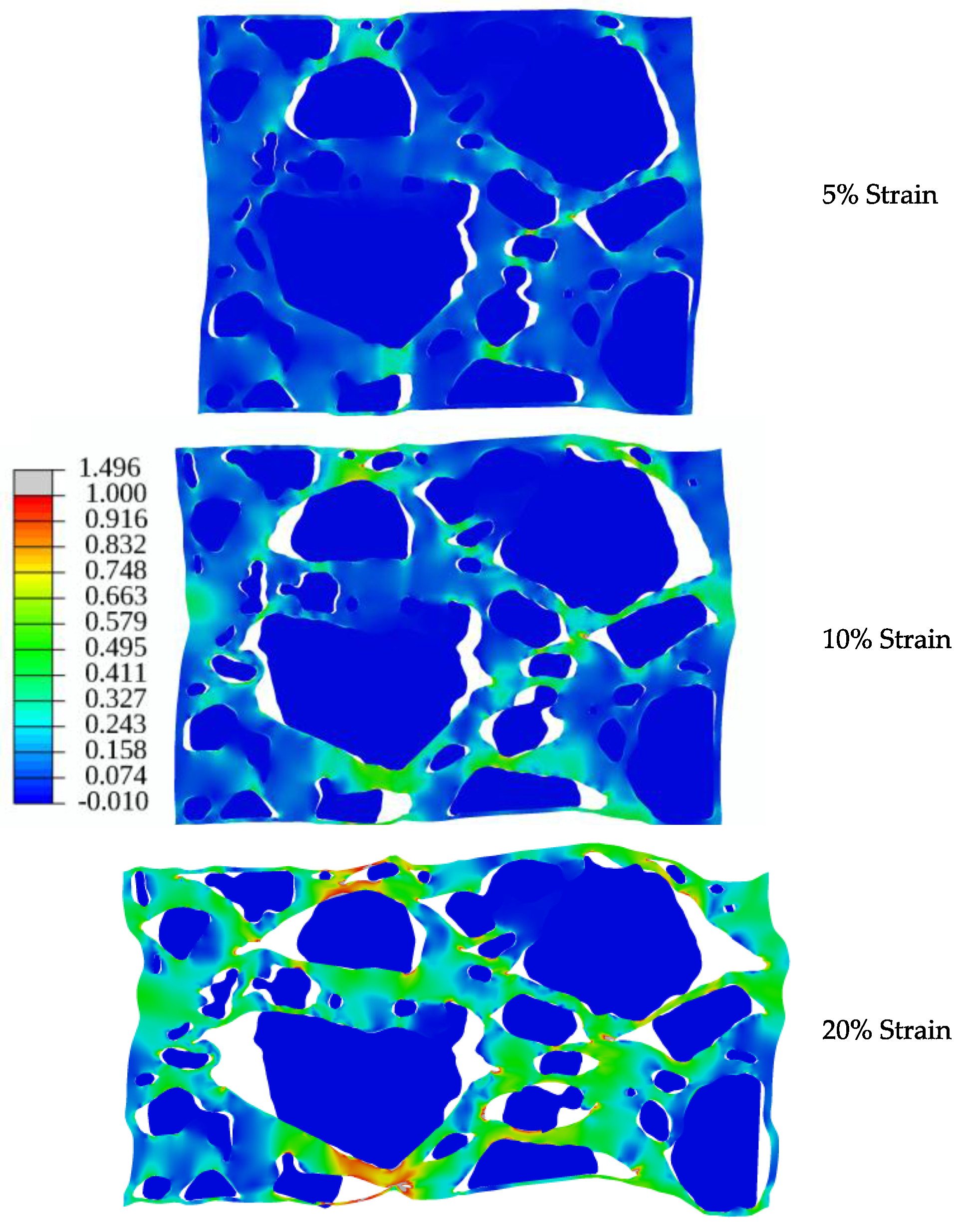
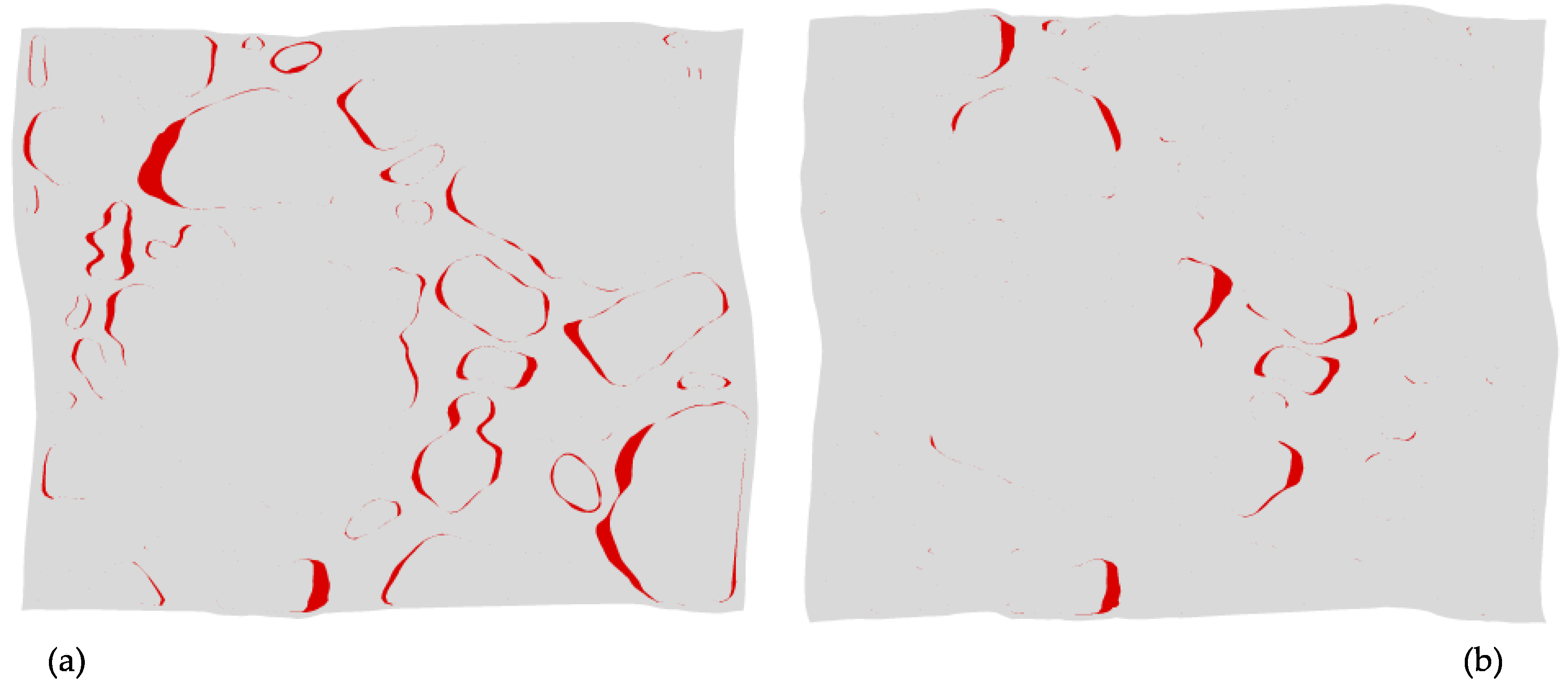
| Formulation | % HMX 1 | % HTPB/DOA/Isonate 2 | % GAP/AMO | Description |
|---|---|---|---|---|
| CF75L | 88.0 | 5.40/5.40/0.53 | 0/0 | Low Isonate, Spongy consistency |
| CF75H | 87.6 | 5.37/5.37/1.02 | 0/0 | High Isonate, Hard cure |
| CF75-AMO1 | 88.0 | 0/0/0 | 3.0/9.0 | Cured with acrylic monomers/oligomers, Hard cure |
| CF75-AMO2 | 88.0 | 0/0/0 | 6.0/6.0 | Cured with acrylic monomers/oligomers, Hard cure |
| Formulation | % HMX Volume | % Binder Volume | % Void Volume | % HMX Mass | % Binder Mass |
|---|---|---|---|---|---|
| CF75L | 57.9 | 41.6 | 0.5 | 74.4 | 25.6 |
| CF75H | 55.9 | 43.6 | 0.5 | 73 | 27.0 |
© 2017 by the authors. Licensee MDPI, Basel, Switzerland. This article is an open access article distributed under the terms and conditions of the Creative Commons Attribution (CC BY) license (http://creativecommons.org/licenses/by/4.0/).
Share and Cite
Manner, V.W.; Yeager, J.D.; Patterson, B.M.; Walters, D.J.; Stull, J.A.; Cordes, N.L.; Luscher, D.J.; Henderson, K.C.; Schmalzer, A.M.; Tappan, B.C. In Situ Imaging during Compression of Plastic Bonded Explosives for Damage Modeling. Materials 2017, 10, 638. https://doi.org/10.3390/ma10060638
Manner VW, Yeager JD, Patterson BM, Walters DJ, Stull JA, Cordes NL, Luscher DJ, Henderson KC, Schmalzer AM, Tappan BC. In Situ Imaging during Compression of Plastic Bonded Explosives for Damage Modeling. Materials. 2017; 10(6):638. https://doi.org/10.3390/ma10060638
Chicago/Turabian StyleManner, Virginia W., John D. Yeager, Brian M. Patterson, David J. Walters, Jamie A. Stull, Nikolaus L. Cordes, Darby J. Luscher, Kevin C. Henderson, Andrew M. Schmalzer, and Bryce C. Tappan. 2017. "In Situ Imaging during Compression of Plastic Bonded Explosives for Damage Modeling" Materials 10, no. 6: 638. https://doi.org/10.3390/ma10060638





